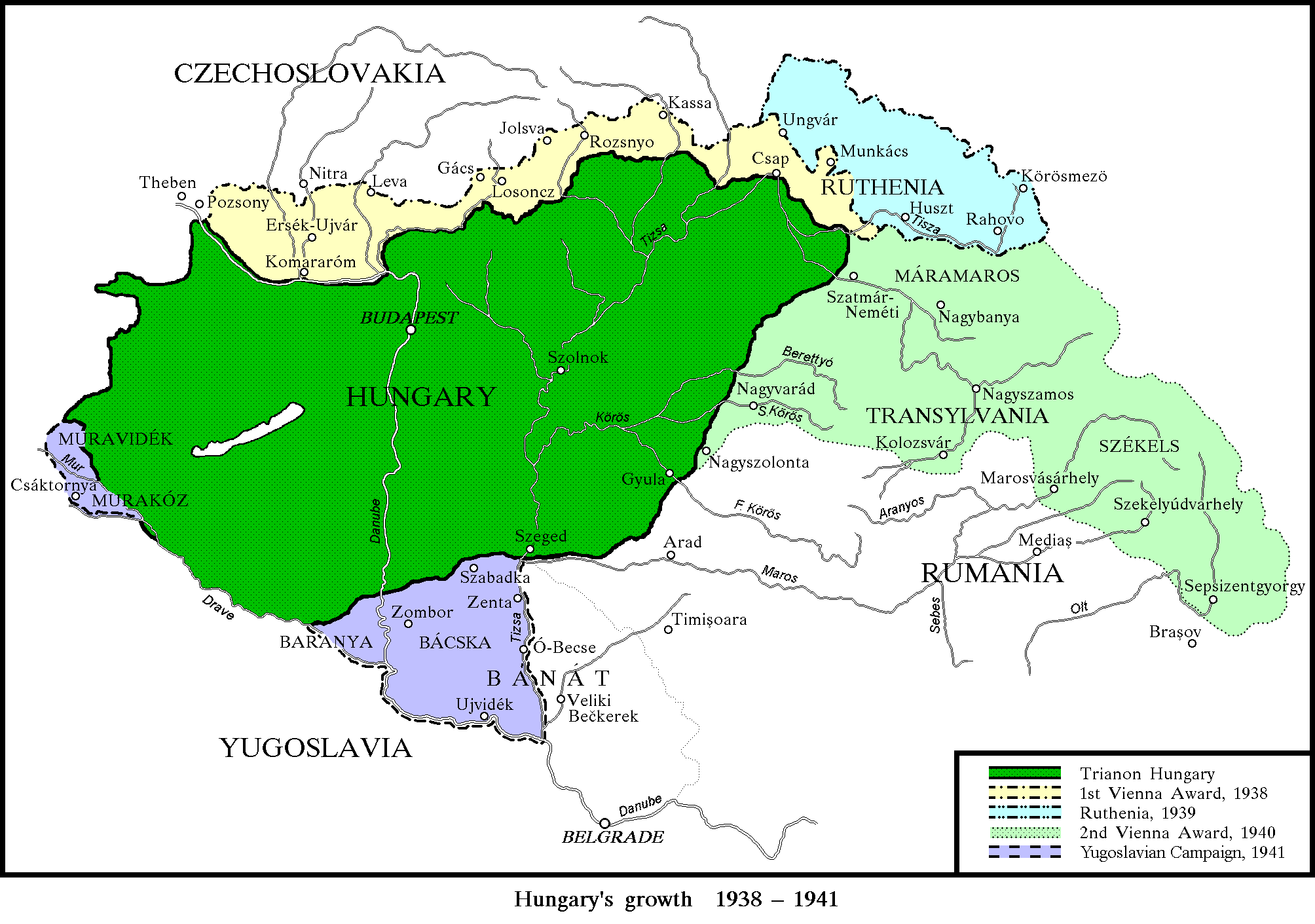| World War II Armed Forces — Orders of Battle and Organizations | Last Updated 12.09.2018 |
|
CHAPTER 1
— Hungary Between the Wars — |
Domestic and Foreign Politics
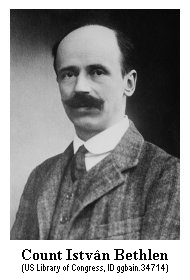 The beginning of the history of the new Hungary can be set at 1.03.1920,
when the Provisional National Assembly was voted into power. One of
the first tasks of the government headed by prime minister Count István Bethlen
was to apply to and, after great difficulties, be finally admitted
to the League of Nations in September 1922.
The beginning of the history of the new Hungary can be set at 1.03.1920,
when the Provisional National Assembly was voted into power. One of
the first tasks of the government headed by prime minister Count István Bethlen
was to apply to and, after great difficulties, be finally admitted
to the League of Nations in September 1922.
In the search for assistance in recovering from its economic chaos, the Hungarian government made overtures to both the victorious and the defeated nations. The depression of the 20's and 30's made the democratic countries reluctant to engage in speculative business with the new Hungarian nation. The newly-emerged governments of Italy and Germany, on the other hand, were eager to obtain recognition and support wherever they could find it, and willing to do something for it. The first step on the road to recovery was initiated by a treaty of friendship with Italy in 1927. The world financial and economic crisis of the early 1930s shattered the barely recovering Hungarian economy. Creditors called in their debts in 1931. Hungary was unable to meet their demands, as the world crisis had destroyed the trade balance which depended on the price of wheat. The government — under the conservative premier Count István Bethlen — appealed to the League of Nations in June 1931 for a loan. The conditions for granting the loan were very strict. Industrial unemployment increased, the rural population was virtually driven into poverty, government employees were dismissed in droves, and those that retained their jobs were forced to take heavy cuts in salary to balance the budget. Count István Bethlen resigned on 24.08.1931. He was succeeded by 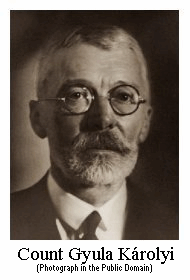 Count Gyula Károlyi
who was also unable to rectify the situation.
Count Gyula Károlyi
who was also unable to rectify the situation.
On 1.10.1932, Horthy appointed as prime minister the leader of the "Right Radicals" Gyula Gömbös. Premier Gömbös was allowed by Horthy to hold elections in 1936, and those had brought into parliament a strong Right Radical element, from which Hungary could never thereafter free itself and which would heavily influence the Hungarian political life. In addition, Hungary's more or less unwilling entry into the Axis camp pulled it unwillingly but inextricably into a similar stance regarding ideology and anti-Semitism as Germany was propagating. The Right Radicals and even elements of the middle classes welcomed the heavy influence Germany had on Hungarian politics. They considered that Germany as an enemy was dangerous, and could easily crush Hungary if it so desired. On the other hand, Germany could be a powerful friend. 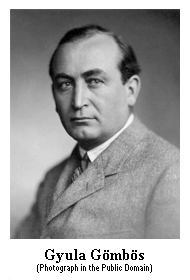 Subsequently, Horthy appointed
Gyula Gömbös,
leader of the Right Radicals, as prime minister on 1.10.1932.
Subsequently, Horthy appointed
Gyula Gömbös,
leader of the Right Radicals, as prime minister on 1.10.1932.
The right wing elements (and almost all of the army officers) thought that if Hitler's policies would lead to war, Germany win that war and then Hungary's revisionary aims would be supported by Germany after the victory. The opposition consisted of elements opposed to the Nazi doctrines including Jews, the Legitimists, the traditionalist Liberal Conservatives , and the Social Democrats. This combination of forces did not believe that Germany would win an eventual war, and that close involvement with Germany would lead to catastrophe. Horthy sympathized with this group. Hungary signed the Rome Protocols on 17.03.35, whereby Italy, Austria and Hungary came to an agreement regarding Hungarian wheat. Italy and Austria agreed to buy Hungarian wheat at twice the going price. This enabled Hungary to buy Austrian and particularly Italian goods, goods also including weapons and armaments forbidden by the Treaty of Trianon. The treaty was also directed against Germany. Hitler then informed the Hungarians that he would support Hungary against Czechoslovakia, but not against Rumania or Yugoslavia. This was a severe blow, as during the time after World War I in which Hungary was rebuilding its shattered state, it had never forgotten the fact that it had lost great portions of its land, population, and natural resources. Its diplomatic endeavors were primarily directed towards rectifying this situation. This policy was known as Revisionism, i.e. revision of the terms of the Treaty of Trianon. 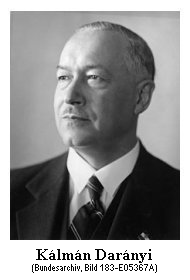 Gömbös died on 6.10.1936. He was succeeded by Kálmán Darányi,
who was more a conservative than a right wing radical. The appointment was ill
received by Germany.
Gömbös died on 6.10.1936. He was succeeded by Kálmán Darányi,
who was more a conservative than a right wing radical. The appointment was ill
received by Germany.
When Italy joined Hitler, Hungary found itself in the Axis camp. The fascist nations were more or less eager to be of assistance. On the other hand, if Germany had applied economic or political pressure, Hungary would have been for all intents and purposes, helpless. In 1937 Hungary obtained the tacit consent of the Small Entente to rearm, although it was still woefully short of armaments. 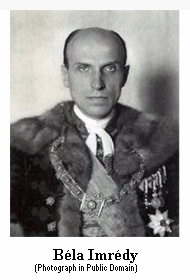 On 14.05.1938 Horthy replaced Darányi with Béla Imry who introduced a
largely token Jewish Law to appease the Germans, although he was
definitely pro-West and not necessarily anti-Jewish. This helped Hungary
during the Munich Crisis in 1938.
On 14.05.1938 Horthy replaced Darányi with Béla Imry who introduced a
largely token Jewish Law to appease the Germans, although he was
definitely pro-West and not necessarily anti-Jewish. This helped Hungary
during the Munich Crisis in 1938.
Further developments in the normalization process took place when Hungary was invited to attend Small Entente Council Conference at Bled in Yugoslavia between 22. and 23.08.1938 at what was to be the last session of that institution. The Small Entente released Hungary from the disarmament clauses of the Trianon Treaty and acknowledged it's right to rearm itself as necessary. In return, Hungary pledged not to reclaim any of the ceded territories by force of arms. The Munich Agreement of 2.09.1938 — which in Neville Chamberlain's words was to assure peace in our time — had just been signed. In accordance with the Agreement, German troops began the occupation of the regions of Czechoslovakia known as the Sudetenland. Abandoned by the Western Democracies, the Czechoslovakian government's only hope was that part of the Munich Agreement which promised that Germany, Italy, France, and England would guarantee the new borders once the Czechoslovakian government had reached agreement with its Polish and Hungarian minorities. However, Czechoslovakia neighbors were placing a more liberal interpretation upon what these agreements were to be. At the time, Hungary did not feel itself strong enough to enforce its demands by military action. The opposite was true. In a meeting of the Hungarian Supreme Defence Council on 20.09.1938, Lajos Keresztes Fischer (Chief of the Military Chancellery) said that in case of a German offensive, Czechoslovakia might attack Budapest, and the Hungarian Army was not strong enough to resist this . The Hungarian Army only had enough ammunition to fight for 36 hours. It was therefore decided to take only defensive measures. On 1.10.1938 German troops marched into the Sudetenland. On the same day, the Polish government demanded of Czechoslovakia some 750 square kilometers of territory, including the cities of Moravská-Ostrava (Ostrawa) and Teschen (Cieszyn). This region hat been in dispute since 1920, when the Paris Peace Conference divided the old Duchy of Teschen between Poland and Czechoslovakia. The Prague government had to accede to the Polish demands, and the territory was handed over on 1.11.1938. Hungary seized the opportunity, and demanded the return of the provinces of Ruthenia and Slovakia — demands so excessive that the Prague government could not possibly acquiesce. Consequently, Czechoslovakia moved troops up to reinforce her common border with Hungary, and began to occupy the bunker systems there. At several points along this border armed clashes took place between Hungarian border forces and Czechoslovakian troops. Meanwhile, destructive forces had been at work in Czechoslovakia. The German-backed and Hungarian-supported nationalistic elements in both Slovakia and Ruthenia pushed for a greater degree of self-determination, and before October 1938 ended, both provinces had been granted autonomy by the harassed Prague government. The Republic of Czechoslovakia had become Czecho-Slovakia hyphenated in both name and fact. Not long after the German occupation, the Hungarian government sought to test the will of the Czecho-Slovakians to resist further territorial loss. On the morning of 5.10.1938, an armed band of 500 men of the Hungarian Ragged Guard [1] attacked the railway station at Borzava and killed a railway man. The invaders then confidently pitched a tent camp in the nearby woods. The Czech troops reacted quickly. They surrounded the Hungarian camp and after a fierce fight forced its surrender. The Hungarians lost 80 men dead and some 400 were captured. The Hungarians were naturally in great haste to get the talks started, as the Czechs had not demobilized, as agreed to in the Munich Agreement. Realizing that the Ragged Guard incident was only an opening move on the part of the Hungarians, the Prague government began to reinforce the troops in the Slovakian region. These consisted of the reliable troops. But although these reinforcements were fully capable of dealing with the weak Hungarian forces, the Czechs suggested that Rumanians occupy Ruthenia. The Rumanians responded positively, on the condition that they be asked officially by the Czech government. The strength of the Czech troops in eastern part of the country comprised the 3rd Czech Army, with 3 Army Corps, and 7 infantry divisions as well as one cavalry division (consisting of one cavalry and one tank brigade), as well as a regiment of aircraft. There were also 10 battalions of miscellaneous border guards, composed of gendarmes, customs police, and selected reservists, which had been mobilized 'sur place' some time before. (General Prchala, Commander 3rd Czech Army). Consequently, a further meeting took place at Komaróm on the Danube River. During this meeting, Hungary demanded minor territorial adjustments: the city of Ipolysag on the Ipel River; the railway station of the city of Csap, both of which were still under Czech control, although they had actually been ceded to the Hungarians. The transfer took place on 11.10.1938. The Czechs refused to consider any further Hungarian claims on their country, although they were apparently ready to negotiate Csallököz (the Great Schütt Island) in the Danube River in return for the waiving of all further claims by Hungary. The Hungarians were not satisfied with this stand, and turned to the great powers once again for judgement. Hungary presented its claims on Czechoslovakia, limiting them to what they thought would be acceptable to the Western powers, whose endorsement they made every effort to obtain. The West ignored them. Hungary had to turn to Germany and Italy. Germany and Italy were quite pleased and willing to be consulted, and were only too willing to intervene. The 1st Vienna Award See also the Wiki article First Vienna Award Joachim von Ribbentrop (the German Foreign-Minister) and Count Galeazzo Ciano (his Italian opposite number) met at Verona on 2.11.1938, and, in the name of the Four Powers, (Germany, Italy, Great Britain, and France !) awarded Hungary those parts of Slovakia and Ruthenia inhabited predominantly by Magyárs, as well as the northeastern Carpathian Mountains, including the important cities of Kassa and Ungvár. The territories awarded to Hungary had approximately 12,103 square kilometers, and some 1,060,000 inhabitants. This regained region of Hungary did not to much to change the structure of the kingdom, as the new regions were comprised mainly of low farm land, on which large quantities of barley, corn, potatoes, and sugar beets were grown. Of the greatest value were the mines, which supplied over half of the Hungarian economy's demand for ores from the date of the takeover. Hungarian troops started taking possession of the regained territories on 5.11.1938. On 6.11.1938, with the Regent Admiral Horthy at its head, the Hungarian Army marched into the city of Komaróm, to the jubilant welcome of its citizens. On the same day, Hungarian troops also crossed over the Danube River at Esztergom to take possession of Csallököz, (the Great Schütt Island). 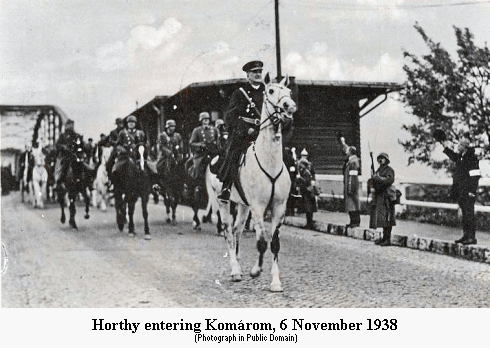 By 8.11.1938, the city of Rozsnyo was reached. On 9.11.1938, Beregszasz
was officially transferred to Hungary. By 10.11.1938, the border towns
of Munkács, Ungvár, Kassa, and Leva were reached, thus terminating the
first military mission, (albeit peaceful) of the new Hungarian Army.
By 8.11.1938, the city of Rozsnyo was reached. On 9.11.1938, Beregszasz
was officially transferred to Hungary. By 10.11.1938, the border towns
of Munkács, Ungvár, Kassa, and Leva were reached, thus terminating the
first military mission, (albeit peaceful) of the new Hungarian Army.
Evacuation of the Ruthenian provincial government from their ceded capital at Ungvár to the mountain village of Huszt was aided by the Czecho-Slovak Army. The Annexation of Ruthenia See also the Wiki article Hungarian invasion of Carpatho-Ukraine Conditions in the remaining part of Ruthenia now became extremely difficult for the Czecho-Slovak central government. The loss of Ungvár had severed all railway transport into Ruthenia. The provincial government, encouraged by the German Foreign Office, continued to make trouble for Prague. The central government was still responsible for the defense of Ruthenia, and troops repeatedly fought irregular marauders from both Hungary and Poland. On 14.03.1938, the autonomous Ruthenian regime adopted a decree changing the name of the province to Carpatho-Ukraine. In this action they were again strongly encouraged by the German Foreign Office which was planing to use this government as a rallying point for anti-Soviet sentiment in the Ukraine. The uneasy peace was soon broken again, when the Sic Guards [2] attacked the city of Munkács on 6.01.1939. The German Army had been disagreeably surprised by the Czech defenses in the Sudentenland, and was worried that, were the Czechs to remain strong, they could become a threat to the German southern flank when the time came to attack Poland. In addition, Germany reasoned that the forthcoming campaign would be much easier if Poland were attacked from a third side as well. It was therefore decided that an independent Slovakian State under German control would be much better than to have Slovakia ceded to Hungary. On the other hand, since the Carpatho-Ukraine government was proving too incompetent to be of much help against Russia, Germany decided that this province be given to Hungary at least as partial compensation for not regaining Slovakia. 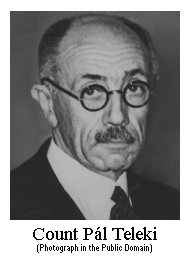 Premier Imrédy resigned in 16.02.1939 . He was replaced by Pál Teleki,
again a pro-West politician.
Premier Imrédy resigned in 16.02.1939 . He was replaced by Pál Teleki,
again a pro-West politician.
By mid-March 1939, the Germans were ready for the final step in the dismemberment of the Czechoslovak Republic. On 14.03.1939, both the Slovak independent movement (under the leadership of Joseph Tiso) and Carpatho-Ukraine, acting on cue from Berlin, declared their complete independence from the central government and placed themselves under Hitler's protection. On 15.03.39 Hitler declared that the unrest in Czecho-Slovakia was a threat to German security, and sent his troops into Prague. The declaration of independence by the Slovak independece movement caused law and order to break down immediately. Sic Guards staged terroristic attacks against the Czech Army, as well as against the pro-Slovak or pro-Hungarian population. On the same day, Hungary had learned that the Germans would not object to a Hungarian take over of the Carpatho-Ukraine. The Carpatho-Ukraine declaration of independence as well as the actions of the Sic Guards was taken as the cue for the Hungarians to demand that the Czech government evacuate its troops and civil servants from the area of the Wooded Carpathians immediately, as they were obviously not capable of guaranteeing the security of the population in the area. The Czech government did not deign to respond to this outrageous statement or the demands, and instead ordered its troops to attack the city of Munkács on the morning of 14.03.1939. The available Hungarian forces consisted of one infantry regiment, two cavalry regiments, three infantry battalions on bicycles, one motorized battalion, two Border Guard battalions, one artillery battalion, two armored trains. These forces numbered not more than two World War II divisions. They were supported by fighter planes amounting to one regiment. Furthermore, the units consisted of 70%–80% recruits who had hardly finished their basic training. The weather in mid-March of 1939 was not very cooperative, with savage snowstorms recurring in the Carpathians. The troops had no mountain training and little special winter clothing and equipment. But morale was high! The Hungarian Border Guard units stationed around Munkács, after throwing back the attacking Czechs on 14.03.1939, pressed forward in turn, and took the town of Orhegyalja (Pidhoriany, part of Mukacheve). On the same day, the Sic Guards and Czech nationalist units initiated large scale partisan operations. Given this welcome excuse, the Hungarian Army regular troops again crossed into Czechoslovakia on 15.03.1939. They reached Szolyva (Svaliava) before nightfall. The Carpatho-Ukrainian irregulars, without support from either Prague or their friends in Berlin, were quickly routed. Czech resistance in Ruthenia was negligible, and the advancing Hungarian troops did not have to count on a well-organized and centralized resistance. The Hungarian Army also had the advantage of the Vienna Award, which made it possible for the Hungarians to take possession of the area where the Czechs built their permanent fortifications against Hungary. On 16.03.1939, Hungary formally annexed the territory. 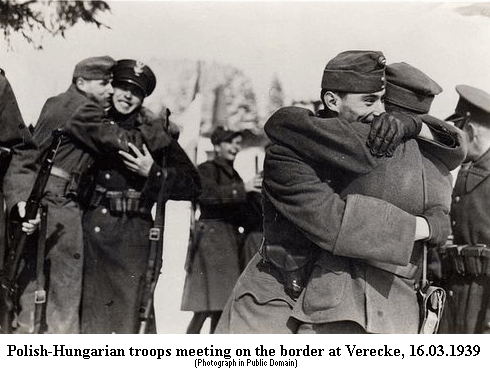
The Hungarian troops continued their advance, pushing forward at top speed and reached the northern border on 16.03.1939. Here they met the Polish troops, who were welcomed with great joy, which, according to C.A. Macartney, was ... probably due to seeing their friends on the frontier and not south of it. [3] This pretty well completed the occupation of Ruthenia. The Hungarian Army's role had been confined to rounding up the Sic Guards. Most of which it executed right away, although some were rescued by the Germans. After the first couple of days of fighting, Czech resistance collapsed and the Hungarian troops reached the ridge of the Carpathians on 18.03.1939. Although the campaign was successful, it proved that the Hungarian Army had yet a long way to go to overcome the handicaps imposed by the Trianon Treaty. On the other hand, it also proved that the military morale and nationalist spirit were high, not only among the troops but in the population at large. Thus an additional impetus was given to those who wanted to build a strong national army. The western provinces of Czechoslovakia were proclaimed as the German Protectorate of Bohemia and Moravia. The Republic of Czecho-Slovakia had been formally dissolved. Hostilities ceased on 18.03.1939, with Hungary in possession of the Wooded Carpathians. Slovak–Hungarian War See also the Wiki article Slovak–Hungarian War Hungary was still not satisfied with her border with Slovakia. Also, the Hungarian Government was well aware that on 23.03.1939, Germany and Slovakia were signing an agreement in which Germany promised to guarantee the Slovak borders. Apparently hoping that the Germans would not feel duly obliged to worry about any territorial changes that took place before this agreement became effective, Hungarian troops — supported by light tankettes — crossed the eastern border of Slovakia early on 23.03.1939, having give the Germans 30 minutes' notice. The Air Force had relocated parts of its forces to the airfields at Debrecen, Ungvár, Miskolc, and Kecskemét. The Hungarian Air Force proved to be superior to that of the Slovak Air Force and quickly achieved air superiority. The demoralized Slovaks did not put up much resistance, but the German reaction was not what the Hungarians presupposed. The Budapest Government was notified that if the Hungarians persisted, German troops would be sent into Slovakia to protect its borders. Consequently, the Hungarians came to a rather sudden halt after advancing some 20–30 kilometers into Slovakia, and pretended that they had never intended to do anything else except occupy a few towns to straighten out the borders in the first place. On 31.03.1939, under strong German pressure, a Hungarian-Slovak commission legalized the Hungarian occupation by granting parts of the west banks of the River Uh to Hungary. This outright annexation of the eastern part of Slovakia gained Hungary 697,788 people, and an area of 12,171 square kilometers. Hungarian losses during operations against the Slovaks were 72 dead, 144 wounded, and 3 missing. When Germany invaded Poland on 1.09.1939, Hungary refused permission for German forces to cross Hungarian territory. During 1940 the Germans considered invading Rumania. They did not discuss this with the Hungarians, as they were (rightly) sure that the Hungarians would pass this information on to the Western Allies. Permission to pass through Hungary was also not discussed by the Germans for the same reason. Instead, evidence exists that the Germans had contemplated marching through Hungary even without that nation's consent. However, agreements were made with the Hungarians, which later allowed the Germans to cross Hungarian territory into southern Rumania. The 2nd Vienna Award See also the Wiki article 2nd Vienna Award Hungary's main foreign policy and diplomatic endeavors continued to be directed towards the reunion of the territories and peoples of the old Hungary as it had been in the times of the Austrian-Hungarian Empire. This lead to a constant friction between Rumania and Hungary, as Rumania was in possession of Transylvania, which was considered by both the Hungarians and the Rumanians as an integral part of those two countries. This conflict of interests lead to the gathering of representatives of the two nations under the supervision of Italy and Germany, at Turnu Severin; there, at the suggestion of Rumania, the respective countries agreed to meet in Vienna and settle the whole thing peaceably, Rumania was relying on its importance to Germany as a major source of oil, and Hungary was relying on its friendship with Italy. In the meantime, during the spring of 1940, the Soviet Union had approached Hungary with the suggestion that if Hungary demand Transylvania back, the USSR would support this. In return, Hungary would have to back the USSR in its moves against Rumania. The strong anti-communist feelings of the Hungarians made them decline. (The USSR did in fact annex Bessarabia and part of Bukovina in June 1940.) In the course of May and June 1940, five corps (I, II, IV, VI, and VIII) and the Mobile Corps were inconspicuously mobilized. The VIII Corps, the Mobile Corps and the Mountain Brigade formed the Second Army, stationed in Ruthenia and around Kassa, in case the Russians should attack across the Carpathians. The First Army, (I, II, IV, VI Corps) under Lieutenant General Vilmos Nagy was to enter Transylvania. In order not to alarm the Rumanians, or perhaps worse still, the Germans, these units were provisionally left in their peace time garrisons. On 22.06.1940, an order was issued freezing all stocks in Hungary of a wide range of materials, principally those useful to military purposes, such as iron and metal articles, petroleum products, chemical and pharmaceutical goods, articles made of leather, rubber or wood, paper, textile goods, and building materials. The rather involved population structure and ethnic minorities in Transylvania made a satisfactory solution impossible. There appeared to be no reason left except that of force. The troops released to gather in the harvest were recalled, and the remaining corps were mobilized (III, V, VII) as the Third Army (Lieutenant General Elemér Gorondy-Novák), and placed next to the Second Army (Lieutenant General Gustáv Jány). Hungary had at this time some 450,000 men under arms. The First and Second Armies had been given orders to advance on 28.08.1940 if no Rumanian acceptance of Hungarian conditions had been received. On 30.08.1940, the Second Vienna Award gave large parts of Transylvania to Hungary. Owing to the political agreement there was no fighting, yet the subsequent move into Transylvania gave the Hungarian General Staff an opportunity to practice in a realistic way how to solve the problems of large troop movements and logistics. Unfortunately, the new borders were drawn without considerations being made regarding geography or ethnic structure. This unsatisfactory solution to the problem only served to further increased the tensions between Rumania and Hungary. Germany was later to feel the results of its meddling when it turned against the Soviet Union, and was in need of allies. These allies were then, unfortunately, too occupied with each other to be inclined to send their full strength to the East, and were always preoccupied that the other did not have too strong an army along the mutual border. The obvious Rumanian dissatisfaction with the solution was evident to the Hungarians. Hungary had ordered a general mobilization of its army even before the Award was concluded, and it was therefore able to send the army across the border into the new territories on 5.09.1940. One wonders if the Hungarians would not have crossed the border anyway, even if the award had not gone their way. All three armies of the Hungarians definitely primed and ready to do so. The Second Vienna Award returned to the Hungarian nation an additional 2,500,000 people, and restored a further 113,000 square kilometers of its territory. The solution provided by the Germans was to have even more fatal results in August 1944 after Rumania changed sides. This opened up the Southern Carpathians, (the Transylvanian Alps) to the Soviet Army, and lost the Germans two entire Armies (6th and 8th), as the Rumanians had been allowed to keep this mountain range and its vital passes. The Second Vienna Award not only awarded northern Transylvania to Hungary, but also large tracts of land to the east. Hungary was hereby afforded new possibilities to improve its economy. These lands awarded to the Hungarians were rich in forests and pastures. Natural resources were not so abundantly present as in the part that remained in Rumanian possession, but there were traces of coal and iron ore. Salt and water power were abundantly present. There were also a few small gold and silver mines as well as a sprinkling of copper and lead deposits. The industrial potential of these territories was not very developed. The possibilities of developing this territory were hampered by the fact that all the rail connections had been severed by the tracing of the new frontier. Hungary signed the Tripartite Pact on 27.09.1940. * * *
^ [1] Ragged Guard (Rongyos Gárda):
An organization that consisted of the remnants of the Székel Division of the old Hungarian army, who having fought against the Rumanians when they had invaded Transylvania, could not return to their homeland. Naturally, not too many of the old members were still available for this type of enterprise, but a few veterans were gotten together to form the nucleus. New personnel consisted mainly of students and younger boys, the majority of which appear to have been Magyars (and even some Ruthenes) from Czechoslovakia. [Page 294, Footnote 5, Macartney, October Fifteenth, Vol. I.]
^ [2] Sic Guards (Also spelled as Sitsch and Sich.)
^ [3] Pages 339, Macartney, October Fifteenth, Vol. I.
A group of badly organized Carpatho-Ukrainian irregulars, authorised by August Volosin, the Ruthanian Prime Minister. [Page 26, Fall, The Ruthenian Question] |
